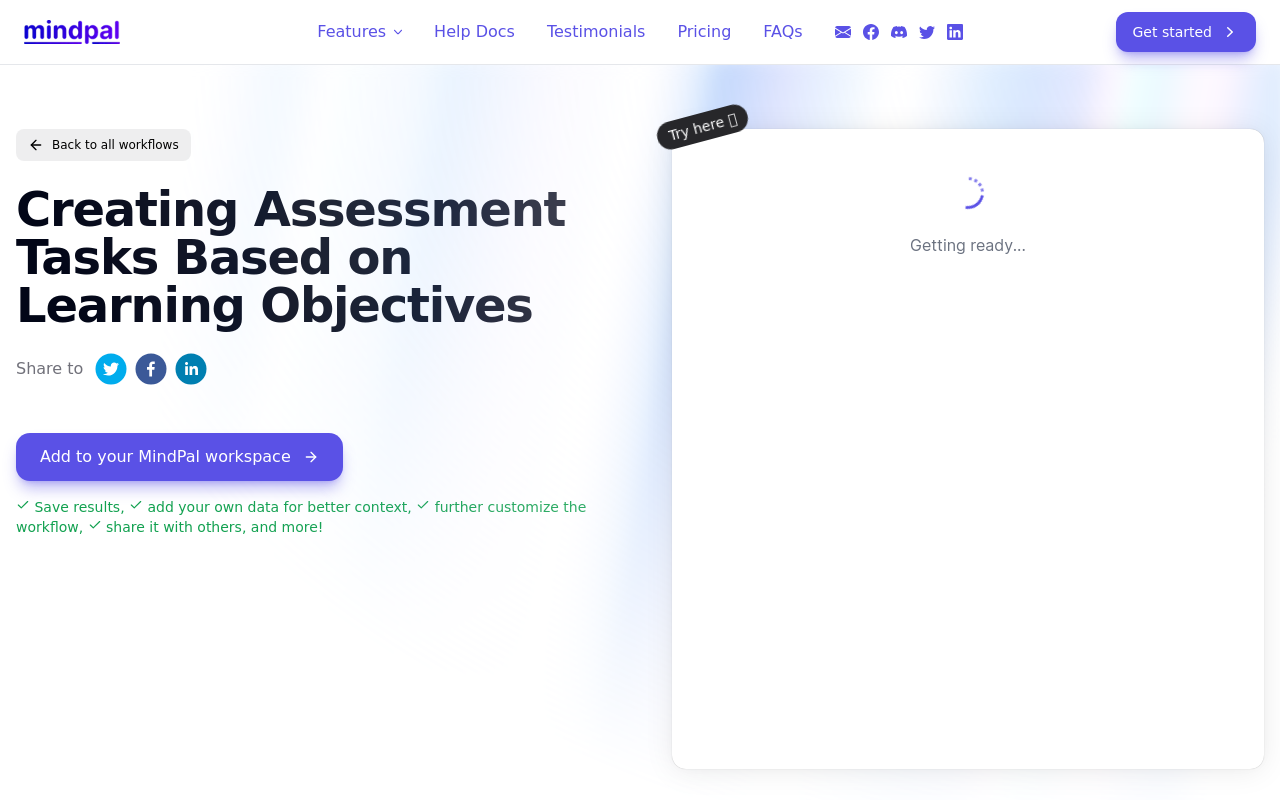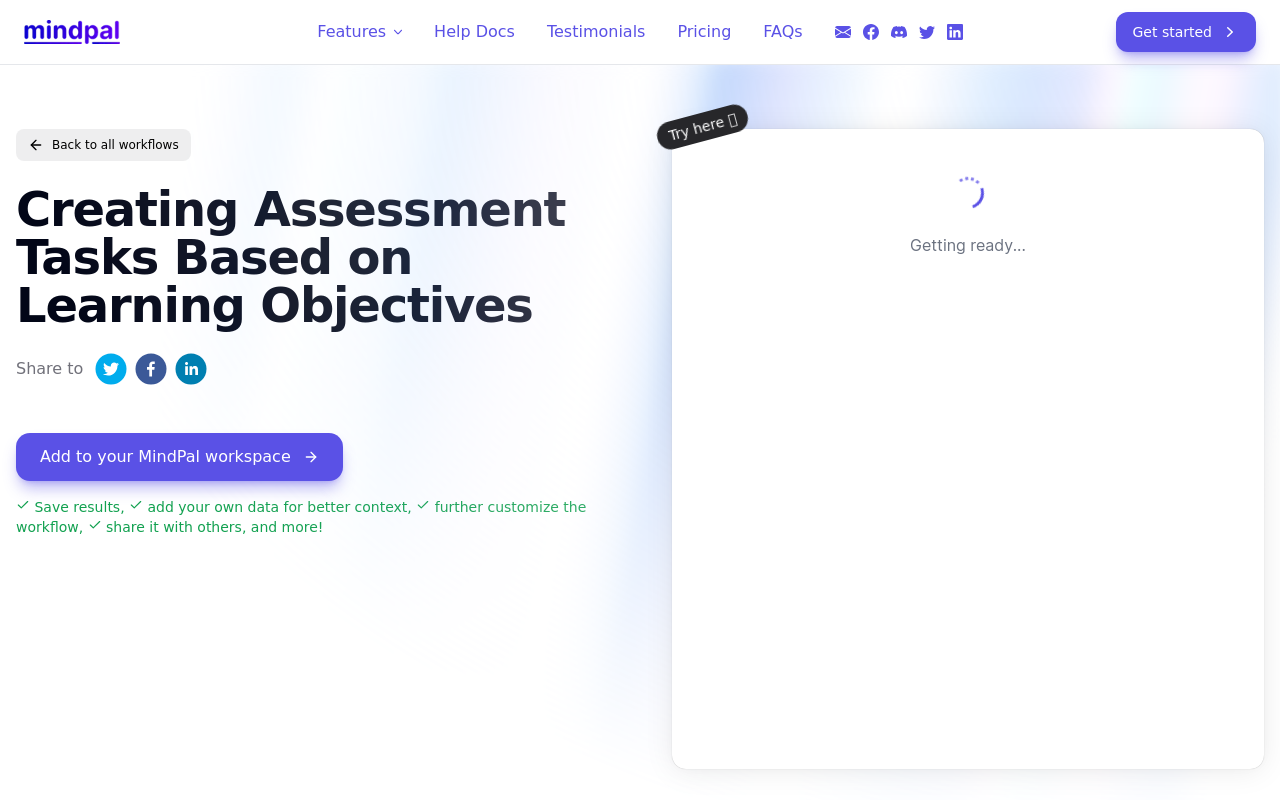Creating Assessment Tasks Based on Learning Objectives
A workflow template that streamlines assessment creation to align with learning objectives
Best for:
- Educators
- Curriculum Developers
- Professional Trainers
Use cases:
- Creating aligned assessment tasks
- Streamlining assessment processes
- Enhancing student outcome measurement
Users like:
- Education
- Curriculum Development
- Training and Development
What is Creating Assessment Tasks Based on Learning Objectives?
Quick Introduction
The ‘Creating Assessment Tasks Based on Learning Objectives’ workflow is designed for educators and curriculum developers who aim to create precise and effective assessments. This tool leverages Bloom’s Taxonomy to help educators generate clear and measurable learning objectives, ensuring that assessment tasks are strategically aligned to gauge the intended cognitive skills and knowledge areas. Whether you are in K-12 education, higher education, or professional training, this workflow is poised to elevate your assessment strategies, making them more impactful and targeted.
At its core, this workflow guides users through a straightforward process to construct tasks that conform to their learning goals. The first step involves generating learning objectives, which are categorized based on Bloom’s Taxonomy. This aids in defining what students need to know and what they should be able to do. The next step is creating assessment tasks that accurately measure these predefined objectives. The result is a more structured and purposeful approach to assessments, promoting fairness, validity, and reliability in measuring student performance.
Pros and Cons
Pros:
- Streamlined Workflow: The two-step process simplifies assessment creation, making it accessible for educators of all experience levels.
- Alignment with Objectives: Ensures assessments are directly aligned with learning objectives, enhancing the accuracy and relevance of the tasks.
- Data-Driven Insights: Helps educators gather and analyze data, refining their teaching methods and improving student outcomes.
Cons:
- Learning Curve: Some users may need time to understand the full capabilities and implementation of Bloom’s Taxonomy within the tool.
- Limited Customization: The predefined structure may not accommodate every unique teaching style or assessment need.
- Tool Reliance: Over-reliance on the tool might reduce the development of educators’ own creative assessment strategies.
TL:DR.
- Generates clear and measurable learning objectives based on Bloom’s Taxonomy
- Creates assessment tasks aligned with predefined learning objectives
- Streamlines the entire process, saving time and reducing complexity
Features and Functionality
- Objective Generation: Utilizes Bloom’s Taxonomy to help users define clear, measurable learning objectives.
- Task Creation: Automatically generates assessment tasks that align with these objectives.
- Data Integration: Allows users to input their own data to customize and fine-tune the resulting assessments.
- Shareable Workflows: Facilitates easy sharing of the workflow with other educators or stakeholders for collaborative input.
- Result Storage: Enables users to save their results and ongoing work within the MindPal workspace.
Integration and Compatibility
This workflow is compatible with the broader MindPal ecosystem, allowing seamless integration with other MindPal tools and resources. It is primarily designed for use within the MindPal platform and does not require additional software or programming knowledge.
Do you use Creating Assessment Tasks Based on Learning Objectives?
This standalone nature ensures simplicity and ease of use, making it accessible for educational professionals without requiring extensive technical skills.
Benefits and Advantages
- Improved Accuracy: Ensures assessments are directly aligned with clearly defined learning objectives.
- Enhanced Productivity: Streamlines the process of creating fair and valid assessments, saving educators valuable time.
- Data-Driven Insights: Facilitates better teaching practices through analysis and adjustment based on accurate assessment data.
- Reliability: Produces consistent and reliable assessments, enhancing the integrity of your educational measurements.
Pricing and Licensing
While specific pricing details are not provided in the text, MindPal typically offers a range of plans tailored to individual or institutional needs, often including trial periods and various subscription models. To explore specific pricing details and licensing terms for this workflow, visiting the MindPal website or contacting their support team would be advisable.
Support and Resources
MindPal provides robust support options, including comprehensive documentation, FAQs, and customer service assistance. Additionally, users have access to a community forum where they can discuss and share insights with other educators. These resources ensure that users can fully leverage the capabilities of the workflow without encountering significant obstacles.
‘Creating Assessment Tasks Based on Learning Objectives’ as an Alternative to Other Apps
Compared to traditional assessment creation tools or general curriculum management software, this workflow stands out by offering a direct alignment with Bloom’s Taxonomy, ensuring that the created tasks are highly relevant and targeted. This focused approach contrasts with broader, less specific tools, making it more effective for educators seeking precision and clarity in their assessments.
Alternatives to ‘Creating Assessment Tasks Based on Learning Objectives’
- Edulastic: A versatile platform for creating standards-aligned assessments with extensive customization options for educators.
- ClassMarker: An online assessment tool that allows for the creation, administration, and grading of quizzes and tests with various question types.
- Kahoot!: Though typically used for engaging, game-based learning assessments, Kahoot! offers robust capabilities for quick formative assessments.
Conclusion
The ‘Creating Assessment Tasks Based on Learning Objectives’ workflow available through MindPal is an invaluable tool for educators looking to create accurate, reliable, and valid assessments aligned with learning objectives. By streamlining the process into clear, straightforward steps and leveraging Bloom’s Taxonomy, this tool ensures that assessments are not only fair and reliable but also highly targeted to measure specific cognitive skills and knowledge. Its integration with the MindPal platform and substantial support resources make it a user-friendly choice for educational professionals aiming to improve their assessment strategies and ultimately enhance student outcomes.
Similar Products
Creating Assessment Tasks Based on Learning Objectives
A workflow template for creating accurate and aligned assessment tasks.



